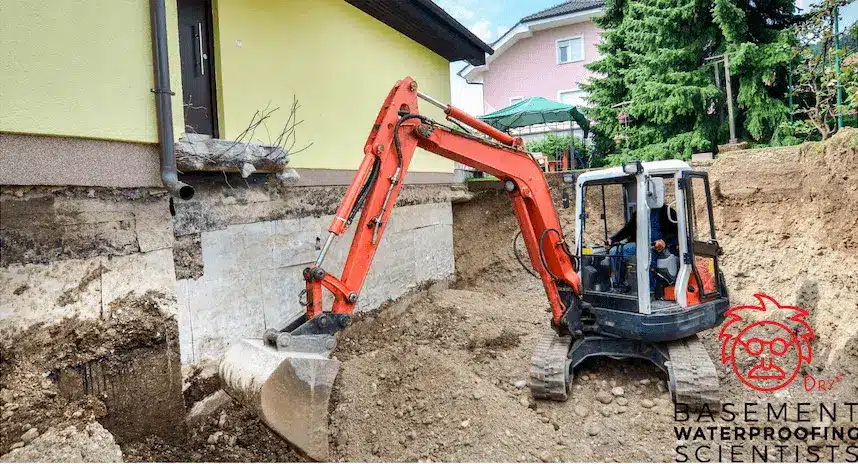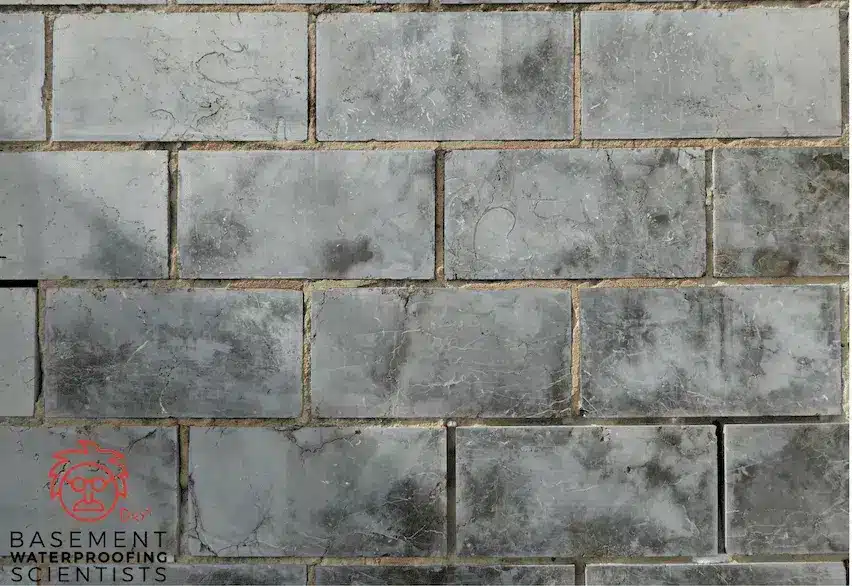What is Exterior Waterproofing?
Exterior waterproofing is the process of sealing your home’s basement walls from the outside to prevent water from seeping in. This is done by excavating the soil around your foundation. The foundation wall is exposed down to the footing. We can then prepare the wall and repair any damage to the surface.
We then apply a thick bituminous exterior waterproofing membrane over the wall and footing.This performs better than polyurethane liquid membrane. This exterior waterproofing membrane prevents water from entering your home through the foundation walls. We then apply a protective layer such as insulation boards so that the membrane is not damaged when the backfill is replaced around the foundation. If there is seepage from more than just the basement walls, you may need interior basement waterproofing.
Click Here for a Free Estimate
Waterproofing Concrete Block Walls From the Outside
Waterproofing Concrete Block Walls From the Outside: A Guide to Protecting Your Hydrostatic pressure can wreak havoc on your home, especially if your walls aren’t properly waterproofed. One area that is particularly vulnerable to water damage is concrete block walls.
Concrete block walls are commonly used in basement and foundation walls, but they can be prone to cracking and leaking if they aren’t properly waterproofed. In this article, we’ll explore the benefits of basement waterproofing concrete block walls from the outside, and provide a guide to help you protect your home from water damage.

Why Waterproof Concrete Block Walls?
Water damage is one of the biggest threats to your home’s foundation. When water seeps into your walls, it can cause a host of problems, including:
– Cracks in the walls and basement floor
– Mold growth
– Structural damage
– Decreased home value
Waterproofing concrete block walls from the outside is important because it helps prevent these problems from occurring.
Foundation Sealer Exterior
Exterior foundation waterproofing is important because it helps prevent these problems from occurring. By creating a barrier that prevents water from seeping into your foundation, you can protect your home and your investment. The foundation sealer used is very thick and bonds to the exterior wall with a waterproof seal. This repels water even when under extremely high pressure. This is usually an alternative method to interior waterproofing.Your content goes here. Edit or remove this text inline or in the module Content settings. You can also style every aspect of this content in the module Design settings and even apply custom CSS to this text in the module Advanced settings.
Benefits of Exterior Foundation Waterproofing
- Protecting your home from water damage: As we mentioned earlier, water can cause a lot of damage to your home’s foundation. Exterior foundation waterproofing helps prevent this damage, which can save you a lot of money in the long run.
- Improving indoor air quality: When water penetrates your foundation, it can cause mold growth. Mold can have a negative impact on indoor air quality, which can be harmful to your health. By preventing water from entering your foundation, you can reduce the risk of mold growth and improve your indoor air quality.
- Increasing home value: If you ever decide to sell your home, exterior foundation waterproofing can increase its value. Homebuyers are often willing to pay more for a home that has been properly waterproofed because they know it’s less likely to have water damage.
- Saving money on energy bills: When water seeps into your foundation, it can cause your home to become damp and cold. This can make your heating system work harder to keep your home warm, which can increase your energy bills. By preventing water from entering your foundation, you can reduce the amount of energy your home uses to stay warm and dry.
How is Exterior Foundation Waterproofing Done?
Exterior waterproofing is typically done in the following steps:
- Backfill: The excavated soil is replaced and compacted.
- Drainage: A drainage system is installed to divert water away from your home’s foundation.
- Restoration: Any landscaping or hardscaping that was removed during the excavation process is restored.
When basement waterproofing with this method, finished basement drywall and fixtures can remained undisturbed.
Exterior Basement Waterproofing: Which Homes are Good Candidates?
If you’re a homeowner, you know how important it is to protect your property from water damage. One area that is particularly vulnerable to water damage is the basement. Water can seep into your basement, causing cracks, mold growth, and even structural damage. One of the best ways to prevent water from penetrating your basement is to invest in is exterior basement waterproofing. But which homes are good candidates for exterior waterproofing? In this article, we’ll explore the factors that make a home a good candidate for exterior basement waterproofing from the outside

1. Age of the Home
Older homes are more likely to have issues with water intrusion in the basement. This is because the materials used to build older homes, such as brick and stone, are more porous than modern materials. Additionally, older homes may not have been built with waterproofing in mind. If your home is older and you’ve experienced water intrusion in the basement, basement waterproofing from the outside may be a good option.
2. Water Table
The water table is the level at which the ground is saturated with water. If your home is located in an area with a high water table, you may be more prone to basement water intrusion. This is because the water pressure around your foundation can increase, causing water to seep through cracks and gaps. If your home is located in an area with a high water table, basement waterproofing from the outside may be a good option to prevent water from entering your basement.
3. Signs of Water Intrusion
If you’ve already experienced water intrusion in your basement, it’s important to address the issue as soon as possible. Water intrusion can cause a host of problems, including mold growth, structural damage, and decreased home value. If you’ve noticed signs of water intrusion in your basement, such as damp walls or a musty smell, basement waterproofing from the outside may be a good option to prevent further water damage.
Contact Basement Waterproofing Scientists today to ensure the longevity and durability of your basement and home.

Get a Free Estimate !
Frequently Asked Questions
Why Are My Basement Walls Bowing?
Your content goes here. Edit or remove this text inline or in the module Content settings. You can also style every aspect of this content in the module Design settings and even apply custom CSS to this text in the module Advanced settings.
Is Mold Dangerous in a Basement or Crawl Space?
Your content goes here. Edit or remove this text inline or in the module Content settings. You can also style every aspect of this content in the module Design settings and even apply custom CSS to this text in the module Advanced settings.
Why is my Basement Damp?
Your content goes here. Edit or remove this text inline or in the module Content settings. You can also style every aspect of this content in the module Design settings and even apply custom CSS to this text in the module Advanced settings.
Who provides exterior foundation waterproofing services in Pennsylvania?
Basement Waterproofing Scientists specializes in exterior foundation waterproofing services throughout Pennsylvania. Our team is equipped with the knowledge and tools to apply waterproof membranes and sealants to your home’s exterior foundation, preventing water intrusion and protecting your home’s structural integrity.
How can I schedule exterior foundation waterproofing services online?
Scheduling exterior foundation waterproofing services is simple. Visit our website and complete the contact form or call us directly to arrange a free consultation. Our team will assess your home’s needs and recommend the best waterproofing solutions to ensure long-term protection.
What is exterior foundation waterproofing?
Exterior foundation waterproofing involves applying protective coatings, membranes, or sealants to the outside of your home’s foundation walls. This process prevents water from penetrating the foundation, reducing the risk of basement flooding and mold growth. It’s an essential step in maintaining your home’s structural health.
Why is exterior foundation waterproofing important?
Exterior foundation waterproofing is crucial because it protects your home from water damage, which can lead to costly repairs and health hazards like mold growth. By preventing water intrusion, you maintain the integrity of your foundation and ensure a dry, healthy living environment.
How long does exterior foundation waterproofing last?
With proper installation and maintenance, exterior foundation waterproofing can last between 10 to 25 years. Regular inspections and timely repairs can extend the lifespan of the waterproofing system, ensuring ongoing protection for your home.
Is exterior foundation waterproofing expensive?
The cost of exterior foundation waterproofing varies based on factors like the size of your home and the extent of the waterproofing needed. At Basement Waterproofing Scientists, we offer competitive pricing and free estimates to help you plan your project within your budget.
Can exterior foundation waterproofing be done in winter?
Yes, exterior foundation waterproofing can be performed in winter, but certain materials may be less effective in cold temperatures. Our team uses specialized products designed for colder conditions to ensure the waterproofing system performs optimally year-round.
Do I need to move out during exterior foundation waterproofing?
In most cases, homeowners do not need to vacate the property during exterior foundation waterproofing. However, depending on the scope of the project, there may be some temporary disruptions. Our team will communicate with you to minimize any inconvenience.
Can exterior waterproofing prevent basement flooding?
Yes, by applying protective coatings and sealants to the exterior foundation, water intrusion is significantly reduced, preventing basement flooding and the associated damage. This proactive approach safeguards your home against water-related issues.
Are there maintenance tips for exterior foundation waterproofing?
Regular maintenance includes inspecting gutters and downspouts to ensure proper drainage, checking for cracks or damage in the waterproofing system, and addressing any issues promptly. Our team can provide guidance on maintaining your exterior foundation waterproofing to ensure its longevity.

